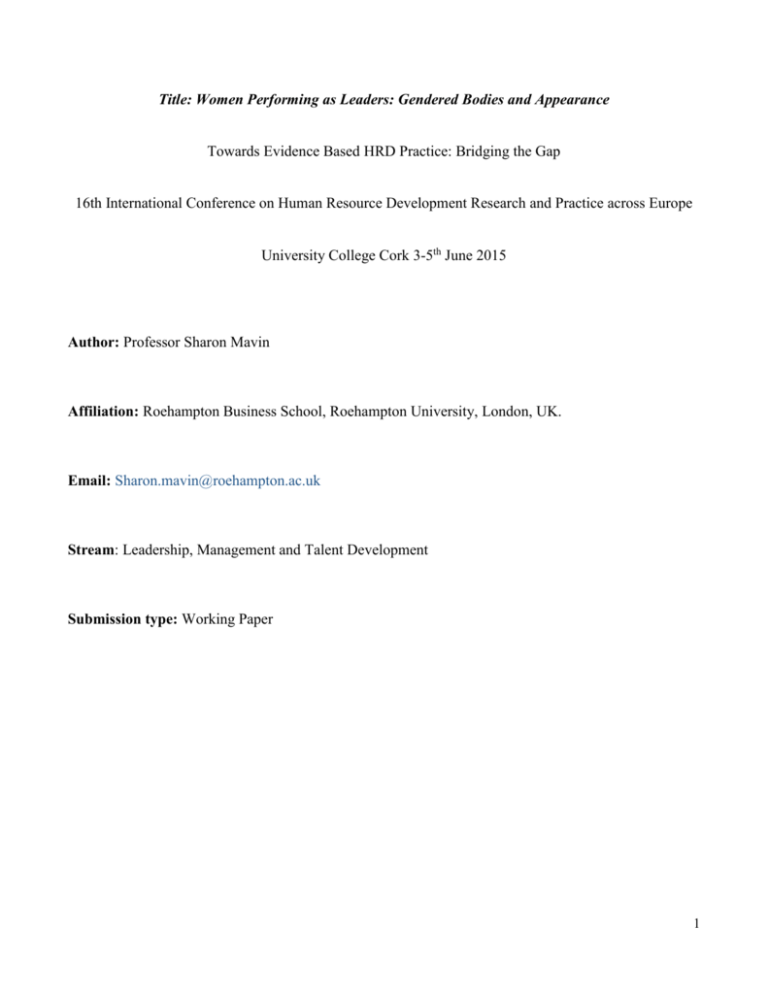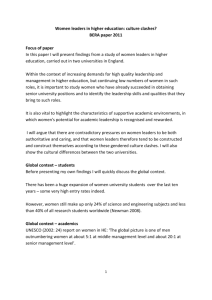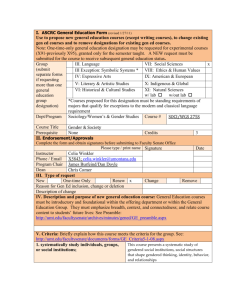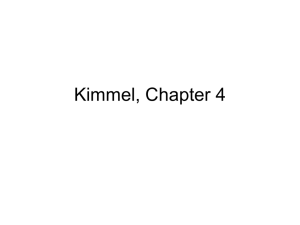Women Performing as Leaders-Gendered Bodies and
advertisement

Title: Women Performing as Leaders: Gendered Bodies and Appearance Towards Evidence Based HRD Practice: Bridging the Gap 16th International Conference on Human Resource Development Research and Practice across Europe University College Cork 3-5th June 2015 Author: Professor Sharon Mavin Affiliation: Roehampton Business School, Roehampton University, London, UK. Email: Sharon.mavin@roehampton.ac.uk Stream: Leadership, Management and Talent Development Submission type: Working Paper 1 Women Performing as Leaders: Gendered Bodies and Appearance Abstract Purpose: The paper outlines research presented to the UK Government Equality Office (October 2014) in response to enquiry into gender stereotypes, gendered constructions, body image and the development of social policy. The key arguments are that body image; bodies and appearance continue to play a significant part in gendering leadership, management and associated careers for women. Design/Methodology/Approach: The paper draws upon a review of extant research and engagement in an empirical qualitative study involving 81 women elite leaders and applies academically rigorous HRD research to the need to improve individual, organizational and societal capability. Findings: There is evidence to demonstrate how perceptions of women’s bodies and appearance i) reinforce gender stereotypes, ii) contest women’s legitimacy and credibility and iii) how women regulate through body work to manage bodies and appearance when they ‘perform’ manager and leader roles against gendered perceptions. This paper briefly communicates current thinking on these issues by focusing upon: how bodies reinforce gender stereotypes in management and leadership; how body image is a source of respectability for women managers and leaders; the impact of gendered media constructions of women managers and leaders and the absence of gender aware management and leadership education and development in business and management schools. Practical and Social Implications: The paper concludes with five policy, educational and practice recommendations in an integrated approach which involves multi-level and multi-sector interventions to challenge gender stereotypes in UK society and education and enable societal and organizational change. Originality/Value: That women leaders’ and managers’ bodies and appearance are under researched. Key Words: Women, Leaders, Bodies, Appearance, Policy-Practice-Change. Women Performing as Leaders: Gendered Bodies and Appearance 2 Introduction The following paper outlines research presented to the UK Government Equality Office (October 2014) in response to enquiry into gender stereotypes, gendered constructions, body image and the development of social policy. In responding to the need to improve individual, organizational and societal capability through the application of academically rigorous applied HRD research, the key arguments are that body image, bodies and appearance continue to play a significant part in gendering leadership, management and associated careers for women. Empirical evidence demonstrates how perceptions of women’s bodies and appearance i) reinforce gender stereotypes, ii) contest women’s legitimacy and credibility and iii) how women regulate through body work to manage bodies and appearance when they ‘perform’ manager and leader roles against gendered perceptions. This paper briefly communicates current thinking on these issues by focusing upon: how bodies reinforce gender stereotypes in management and leadership; how body image is a source of respectability for women managers and leaders; the impact of gendered media constructions of women managers and leaders and the absence of gender aware management and leadership education and leadership in business and management schools. The paper provides a summary of key research in relation to each of these areas and concludes with five recommendations for policy, educational efforts and practice. 3 Bodies: Reinforcing Gender Stereotypes in Management and Leadership Women’s professional identities in business, management and leadership are gendered due to stereotypes associated with masculine-feminine social and cultural norms (Haynes, 2012) and subsequently management and leadership is sex-role stereotyped (Vinnicombe and Singh, 2002) with men as the norm. Within this context bodies (as embodied selves) are sites of power and identity (Haraway, 1990) and women’s body image conveys their plausibility or otherwise as managers and leaders. Men’s bodies are regarded as normative; they have neither sexuality nor gender (Acker, 2003) and men are managers and leaders (Schein and Davidson, 1993). Women’s bodies bring gender and sexuality; are troubling bodies at work (Brunner and Dever, 2014) and a means of contesting women’s legitimacy. Women’s bodies at work (Wolkowitz, 2006) are subjected to a controlling masculine rationality through embodied characteristics e.g., voice, weight, self-presentation, crucial to legitimating hierarchical evaluations of worth (Haynes, 2012).Women thus face pressures to control their embodiment against expectations of credibility and evaluations of hierarchical worth (Haynes, 2012) and are judged more on their bodies in a way that men are not (Sinclair, 2013). For example for women accounting professionals the body is significant as a vehicle for displaying conformity and non-conformity to gendered stereotypes (Haynes, 2008). Professional women must appear feminine, while emulating business leadership masculinity (Entwistle, 2000). The ‘ideal’ elite leader body is male; an idealised bounded space, where gendered body constructions position women’s bodies as an embodiment of the failure to live up to the norm (Russell, 2013). Normative stereotypes of ‘professional/manager/leader as man’ are reinforced through the suit worn by business ‘men’ - as a masculine symbol of credible management (Kelan, 2013), while the skirted suit became a standard for professional women during 1963-1983 to distinguish from secretaries (Kelan, 2013; Saunders and Stead, 1986). There is evidence that gender stereotypes of 4 professional/manager/leader are ‘stretching’ (Billing, 2011) reflecting increasing numbers of women in these roles, and developing ‘fluidity’ in relation to the ‘acceptability’ of men and women doing both masculinity and femininity (Mavin and Grandy, 2012). Yet women remain extra visible as women and invisible as professionals/managers/leaders (Simpson and Lewis, 2005). Their authenticity is judged through the lens of gender, as women and as bodies (Sinclair, 2013). Women are scrutinized through gendering processes when ‘power dressing’ as honorary men (to be taken seriously and drawing attention away from feminine difference), or presenting themselves as ‘too feminine’ to be taken seriously (Brewis et al., 1997) - a situation not faced by men. Contingent upon what ‘position power’ they hold or how masculine or feminine their style, women’s body image continues to attract significant scrutiny and criticism (Sinclair, 2011). Women’s bodies and appearance in leadership make a statement not only about their occupational identity and professionalism but also how they position themselves in relation to the ideals of masculinity and femininity within a heterosexual paradigm (Kelan, 2013). Women elite leaders disrupt gendered norms and within a context of competitive masculinity, women who secure positions historically held by men have achieved a particular parity with the One (De Beauvoir, 1949). They ‘share’ space within a gendered order, holding significant organisational power. Yet, as female bodies women simultaneously exist on the boundaries, threatening and disturbing the strategic masculine prerogative (Tyler, 2005); paradoxically both One and the Other in social relations. Their maternal bodies can serve to remind themselves and others of their ambiguous, in-between (Tyler, 2011) status. Mavin and Grandy (2015) highlight how women elite leaders struggle with their desire for acceptance and recognition and how in intra-gender relations with other women, women’s bodies are admired-weak bodies which fit, stretch to meet or do not meet, perceived requirements of elite leaders’ bodies 5 Body Image as a Source of Respectability for Women Managers and Leaders Body image also indicates respectability for women (Mavin and Grandy, 2014). Old habits die hard and although women managers and leaders have increased in numbers, their bodies remain a means of reproducing dominant practices of social control (Bell and Sinclair, 2014). Respectable femininity ideology from the 19th Century, supports a set of behavioural norms (Radhakrishnan, 2009) e.g. respectable women dressed modestly, demonstrated self-restraint, were sober, well-mannered and confined themselves to mainly private spaces (Fernando and Cohen, 2014). This ideology manifests in contemporary ways through women leaders’ bodies and appearance in relations with men and with women. Women leaders are variously informed what bodies and appearance are appropriate / inappropriate for leader positions (Mavin and Grandy, 2014). Women are definable by bodies, reproductive capacities and shaped by body rules for what is body appropriate (Trethewey, 1999; Sinclair, 2011) to ‘fit’ into management and leadership. Fitting in requires women to engage in body work (Gimlin, 2002; Wolkowitz, 2006) to regulate their bodies and negotiate professional expectations of demeanour, dress, appearance and self-presentation (Haynes, 2012; Stead, 2013). This is vivid when women work when pregnant and return as mothers to perform as managers and leaders. Their leaky bodies are reminders of their feminine sexuality and women professionals and managers report anxieties about becoming a source of disgust and having their roles/positions revised negatively as a result (Gatrell, 2013). Women’s bodies are regulated so as not to appear too sexy, mother-like (too feminine), fat (lack of control) or too masculine against ambiguous gendered body rules of the ideal woman leader. When women get respectable femininity ‘right’ they accrue respect as a woman and as a leader but when they get this wrong, their respectability as a woman and credibility as a leader is at risk (Mavin and Grandy, 2014). The ideal businesswoman is professional without upsetting the gender norms (Kelan, 2013) – we fit in. Respectable femininity norms are also seen through women’s negative intra-gender relations with other women at 6 work (Mavin, 2006), where their bodies and appearance become symbols of women’s competitive relations and micro-violence (Mavin et al., 2014a) between women in a context of scarce resources (e.g. limited promoted positions for women), constraining potential for solidarity behaviours, sponsorship, mentoring and role modelling (Mavin, 2006). Bodies and appearance become sites through which women may undermine and alienate other women and experience back-lash responses from other women (Mavin and Williams, 2013). Gendered Media Constructions of Women Managers and Leaders Continued research into the gender-media dyad remains critical (Ross, 2010). The media’s power in perpetuating gendered constructions of women managers and leaders’ bodies and appearance (Mavin et al., 2010; Elliott et al., 2014) strengthening gendered stereotypes of manager and leader as men, constraining women’s authenticity and reinforcing respectable femininity norms, cannot be underestimated. Media representations have enormous impact on how women are viewed and view themselves (Elliott, et al., 2014; Gill, 2006; Van Zoonen, 1994), providing ‘how to templates’ for women to appear business like (Kelan, 2013). Media and marketing through advertising, media images and product symbolism, play a role in consumers’ perceptions of body image and whose bodies count shaping cultural ideology that underlies consumers’ sense of an ideal or more desirable body (Woodruffe-Burton and Ireland, 2011). Bodies are understood through images (Coleman, 2008) and identities are constructed and reinforced in relation to media images e.g. women are judged based on the images of professional businesswomen (Kelan, 2013). Media continues to follow the ‘Hemlines, Husbands and Hairstyles’ format (Mavin et al., 2010), gendering women leaders as women e.g. in the case of women political leaders ‘Blair’s Babes, Gordon’s Gals, Cameron’s Cuties and Nick’s Nymphets’ (Mavin et al., 2010; Ross and Sreberny, 2000) and in business, ‘Mother of three poised to Lead the BBC’ (The Telegraph, 2014). Media constructions of women leaders are often absent, gendered, sexualised and evidenced by contradiction e.g. 7 the championing of women leaders, versus a focus on hair, makeup, clothes, children, weight or constructing women as Queen Bees (Mavin, 2008), calling into question women’s presence and competence (Elliott et al., 2014). While the UK and European Governments grapple with societal and economic inequalities (Horizon 2020); the lack of women in leader roles and impact of legislative quotas (e.g. Davies, 2011; The EU Justice Commissioner 2013), the media continues to communicate gendered misrepresentations of women professionals and leaders (Elliot et al., 2014). Gender Neutral and Gender Blind Business, Management and Leadership Education UK Business and management Higher Education has seen unprecedented growth with Business Schools (BSs) contributing £3.25 billion to the UK economy and students representing 1 in 5 PG and 1 in 7 UG students attending university (ABS, 2014a). BSs, as well as colleges and schools are uniquely placed to play a critical role in enabling individuals and organisations to critically challenge ways of working and thinking (Mavin and Bryans, 1999). However ‘mainstream’ research, theory and learning education fails to recognise relationships between management and gender and operates a gender neutral or gender blind approach, promoting an absence of women and reinforcing management and leadership as a man-only space (Wilson, 1996; Mavin and Bryans, 1999; Mavin et al., 2004; Simpson, 1995; 2005). Despite increasing numbers of women students at UG and PG levels to approx. 50%, discussions of gender and gender awareness in business curricula (i.e. examples of women performing as managers and leaders) are primarily absent and seen as unnecessary (Mavin and Simpson, 2014; Elliott and Stead, 2008). Global/international diversity is more likely to be included in curricula and in policy directing the skills development for future managers and leaders, than gender diversity (Mavin and Vinnicombe, 2014). Women and men learning business and management ‘cannot be what they cannot see’ or cannot identify with. The ‘flagship’ Master of Business Administration (MBA) constructs business and management as masculinity (Simpson, 2006) and perpetuates gender stereotypes (Sinclair, 1995; Lamsa and Savela, 2014; 8 Kelan, 2013). As an entry qualification into middle and senior roles, evidence suggests that while women are more likely to undergo ‘transformational’ change by studying an MBA, it is men who achieve greater progress in terms of career development and pay (Simpson and Ituma, 2009). Women students on the MBA report women academics in the classroom as rare and there is evidence that Undergraduate students cannot name women leaders from case studies and teaching materials (Woodward, 2014) but they can provide the names of men leaders. There is a problem with business, management and leadership curricula and the academics who deliver and research in the subject where gender is seen as ‘sorted’ and no longer an issue or not a fitting discussion for such an objective masculine subject. Interventions are required to engage academics to mainstream issues of gender diversity. Women academics’ bodies in business and management are also of concern and are lacking in visibility in Professorial and senior leadership roles with ABS (2015) noting that hold 23% of UK Dean positions and 21.7% of Professorships (ABS, 2014b) in UK BSs. If women are 51% of the UK population and approximately 50% of business and management students, the systematic gender inequality embedded within a so-called meritocratic sector should be challenged structurally and instrumentally and possibly legally. Calls for change to learning curricula and mainstreaming ‘gender in management’ research (Mavin and Bryans, 1999; Mavin et al., 2004) are growing. However to attack and dismantle gender stereotypes and normalise women’s bodies in learning requires significant ‘unlearning’ and a ‘rethinking’ of approaches to developing the next generations of professionals, managers and leaders (Mavin and Bryans, 1999; Bryans and Mavin, 2003). Achieving this may require similar structural regulatory interventions as quotas for women on company boards, held accountable by government and professional bodies (e.g., HEFCE/QAA, ABS, CIPD, CMI) and Business School accreditation bodies (e.g., AACSB, EQUIS, AMBA). Further, gender inequality has become concern for UK Higher Education in general, with a summit held at Cambridge University in March 2015 engaging stakeholders and senior HE leaders in 9 debates about how to tackle endemic gender inequality across the disciplines. Solutions based on generational change and ‘the pipeline’ are no longer acceptable as their impact has been largely absent. Learning from the interventions relating to women on company boards in the UK, targets for women in Professoriate and senior leader positions with accountability to the Higher Education Funding Council for Education and related financial penalties for lack lustre performance and non-commitment may be the only way forward to tackle institutional and sector-wide sexism in the UK. Proposed Recommendations for Practice and Policy The following policy and practice recommendations concern an integrated approach which involves multilevel and multi-sector interventions to challenge gender stereotypes in UK society and education. 1) Policy and educational efforts are required to normalize women’s bodies in business, management and leadership, from nursery education onwards where young children learn to recognize and associate men and women with professional roles and not gendered segregated roles. 2) Policy and regulatory intervention is required to promote a wider range of manager and leader gender aware constructions or representations in marketing and promotional materials in society, organisations and media. 3) Social policy intervention and regulation of gendered media constructions is fundamental to challenging and changing gendered stereotypes and normalising women as professionals, managers and leaders. 4) In Business Schools the introduction of gender diversity accountability measures is critical to address gender defensiveness or blindness amongst academics and senior leaders. In order to deliver societal change it is imperative that Business Schools, Further Education Colleges and Nursery-Junior-High Schools are held accountable for mainstreaming gender diversity into core curricula via existing multiple regulatory, accreditation and professional bodies. 5) In High Schools and BSs this should include having visible women as role models (i.e. academics/leaders), examples and case studies for young women and men studying ‘business and management’ at different educational levels. 10 References Acker, J. (2003) Hierarchies, jobs, bodies. In Ely, R.J., Foldy, E.G. and Scully, M. (eds) Reader in Gender, Work, and Organization, 49–61. Malden, MA: Blackwell Publishing. Association of Business Schools (2014a) Business Schools Supporting Small Businesses and Local Economies: A Manifesto for Growth, supported by Small Business Charter. Association of Business Schools (2014b) Business School Leadership: Gendered or Genderless? http://associationofbusinessschools.org/content/business-school-leadership-gendered-orgenderless#sthash.afQoJY4M.dpuf. Bell, E. and Sinclair, A. (2014) Reclaiming eroticism in the academy. Organization, 21,2, 268-280. Billing, Y. D. (2011). Are women in management victims of the phantom of the male norm?. Gender, Work & Organization, 18(3), 298-317. Brewis, J., Hampton, M. P., & Linstead, S. (1997). Unpacking Priscilla: subjectivity and identity in the organization of gendered appearance. Human Relations, 50(10), 1275-1304. Brunner, L. K. and Dever, M. (2014) Work, bodies and boundaries: talking sexual harassment in the new economy. Gender, Work & Organization, 21, 5, 459–71. Online First doi: 10.1111/gwao.12048. Bryans, P., & Mavin, S. (2003). Women learning to become managers: learning to fit in or to play a different game?. Management Learning, 34(1), 111-134. Coleman, R. (2008). The becoming of bodies: Girls, media effects, and body image. Feminist Media Studies, 8(2), 163-179. Davies, Lord (2011) ‘Women on Boards’. Available at: www.gov.uk. De Beauvoir S (1949) The Second Sex (trans. & edited by HM Parshley, 1989). Toronto, Canada: Vintage Books. 11 Elliott, C. Mavin, S., Stead, V. and Williams, J. (2014-7) ESRC Funded Seminar Series, Challenging Gendered Mis(s)Representations of Women Professionals and Leaders, led by Durham Univesity. Elliott, C., & Stead, V. (2008). Learning from leading women's experience: towards a sociological understanding. Leadership, 4(2), 159-180. Entwistle, J. (2000). Fashioning the Career Woman: Power Dressing as a Strategy of Consumption. In M. R. Andrews & M. M. Talbot (Eds.), All the World and Her Husband (pp. 224-238). London Cassell. Fernando, W., and Cohen, L. (2014) Respectable femininity and career agency: exploring paradoxical imperatives. Gender, Work & Organization, 21,2, 149-64. Gatrell, C. (2013) Maternal body work: how women managers and professionals negotiate pregnancy and new Motherhood at work. Human Relations, 66, 5, 621-44. Gill, R. (2006). Gender and the Media. Cambridge: Polity Press. Gimlin, D. (2007) What is ‘body work’? A review of the literature. Sociology Compass, 1,1, 353-70. Haraway, D. (1990) A manifesto for cyborgs: science, technology, and socialist feminism in the 1980s. In Nicholson, L. (eds) Feminism / Postmodernism, 190-233. London: Routledge. Haynes, K. (2012) Body beautiful? Gender, identity and the body in professional services firms. Gender, Work &Organization, 19, 1, 489-507. Haynes, K. (2008) (Re)figuring accounting and maternal bodies: the gendered embodiment of accounting professionals. Accounting, Organizations and Society, 33,4–5, 328–48. Kelan, E. K. (2013). The becoming of business bodies: Gender, appearance, and leadership development. Management Learning, 44(1), 45-61. Lämsä, A.M. & Savela, T. (2014) The effect of an MBA on the development of women's management competencies: A gender viewpoint, Baltic Journal of Management, Vol. 9 Iss: 2, pp.213 – 230. 12 Mavin, S., & Bryans, P. (1999). Gender on the agenda in management education?. Women in Management Review, 14(3), 99-104. Mavin, S., Grandy, G. and Williams, J. (2014) Experiences of women elite leaders doing gender: intragender micro-violence between women in management. British Journal of Management, 25,3,439-55. Mavin, S. and Simpson, R. (2014) Gender on the Agenda in Management Education: Reflections on Research & Practice, Keynote presentation to British Academy of Management, Gender in Management SiG seminar on gender on the agenda in business schools, London, June. Mavin, S. and Vinnicombe, S. (2014) What is good leadership & what are the implications for management teaching?, Keynote presentation as part of British Academy of Management (BAM) Fellow’s Panel, Annual BAM Conference, Belfast, September. Mavin, S., & Grandy, G. (2014) Abject Appearance: Women Elite Leaders’ Intra-gender ‘Management’ of Bodies and Appearance, under review for Human Relations. Mavin, S., & Grandy, G. (2014) Respectable Femininity and Intra-gender Regimes of Regulation: Experiences of Women Elite Leaders, International Gender Work and Organization Conference, June, Keele, UK. Mavin, S., & Williams, J. (2013). Chapter 8. Women’s impact on women’s careers in management: queen bees, female misogyny, negative intra-relations and solidarity behaviours. Handbook of Research on Promoting Women’s Careers, 178. Mavin, S., & Grandy, G. (2012). Doing gender well and differently in management. Gender in Management: An International Journal, 27(4), 218-231. Mavin, S., Bryans, P., & Cunningham, R. (2010). Fed-up with Blair's babes, Gordon's gals, Cameron's cuties, Nick's nymphets: challenging gendered media representations of women political leaders. Gender in Management: An International Journal, 25(7), 550-569. 13 Mavin, S. (2008). Queen bees, wannabees and afraid to bees: no more ‘best enemies’ for women in management?. British Journal of Management, 19(s1), S75-S84. Mavin, S. (2006). Venus envy: problematizing solidarity behaviour and queen bees. Women in Management Review, 21(4), 264-276. Mavin, S., Bryans, P., & Waring, T. (2004). Unlearning gender blindness: new directions in management education. Management Decision, 42(3/4), 565-578. Radhakrishnan, S. (2009) Professional women, good families: respectable femininity and the cultural politics of a “new” India. Qualitative Sociology, 32,2, 195-212. Ross, K. (2010). Gendered Media. Lanham, MD, Rowman and Littlefield. Ross, K., & Sreberny, A. (2000). Women in the House: Media representation of British politicians. Gender, politics and communication, 79-99. Russell AM (2013) Embodiment and abjection trafficking for sexual exploitation. Body & Society. 19(1): 82-107. Saunders, C. S., & Stead, B. A. (1986). Women's adoption of a business uniform: A content analysis of magazine advertisements. Sex Roles, 15(3/4), 197-205. Schein, V. E., & Davidson, M. J. (1993). Think manager, think male. Management Development Review, 6(3). Simpson, R., & Ituma, A. (2009). Transformation and feminisation: the masculinity of the MBA and the “un-development” of men. Journal of Management Development, 28(4), 301-316. Simpson, R. (2006). Masculinity and management education: feminizing the MBA. Academy of management learning & education, 5(2), 182-193. Simpson, R., Sturges, J., Woods, A., & Altman, Y. (2005). Gender, age, and the MBA: an analysis of extrinsic and intrinsic career benefits. Journal of Management Education, 29(2), 218-247. 14 Simpson, R., & Lewis, P. (2005). An investigation of silence and a scrutiny of transparency: re-examining gender in organization literature through the concepts of voice and visibility. Human Relations, 58(10), 1253-1275. Sinclair, A. (2013). 18. Essay: can I really be me? The challenges for women leaders constructing authenticity. Authentic Leadership: Clashes, Convergences and Coalescences, 239. Sinclair, A. (2011) Leading with body. In Jeanes, E., Knights, D. and Martin, P. (eds) Handbook of Gender, Work And Organization, 117-30. Chichester: John Wiley & Sons. Sinclair, A. (1995). Sex and the MBA. Organization, 2(2), 295-317. Stead, V. (2013). Learning to deploy (in) visibility: An examination of women leaders’ lived experiences. Management Learning, 44(1), 63-79. Trethewey, C. (1999) Disciplined bodies: women’s embodied identities at work. Organization Studies, 20, 3,42350. Tyler M (2011) Tainted love: From dirty work to abject labour in Soho’s sex shops Human Relations. 64(11): 1477-1500. Tyler M (2005) Women in change management: Simone De Beauvoir and the co-optation of women's Otherness. Journal of Organizational Change Management. 18(6): 561-577. Van Zoonen, L. (1994). Feminist media studies (Vol. 9). Sage. Vinnicombe, S., & Singh, V. (2002). Sex role stereotyping and requisites of successful top managers. Women in Management Review, 17(3/4), 120-130. Wilson, F. (1996). Research note: organizational theory: blind and deaf to gender?. Organization Studies, 17(5), 825-842. Wolkowitz C (2006) Bodies at Work. London: Sage. 15 Woodruffe-Burton, H.R. and Ireland, K. (2011) Lived consumer bodies: Narcissism, Bodily Discourse and Women’s Pursuit of the Body Beautiful chapter in Gender, Culture and Consumer Behavior, Celetnes and Linda Tuncay Zayer (Eds), Psychology Press, London UK and Florence, KY, USA, pp: 195-222. 16








